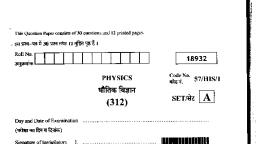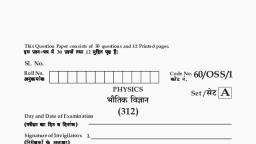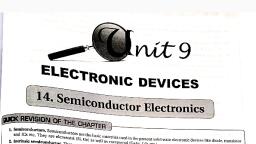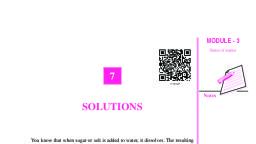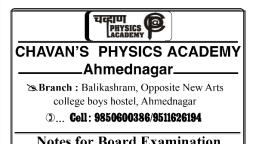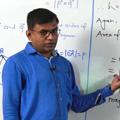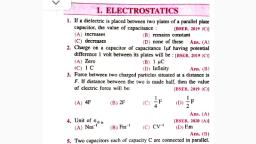Page 1 :
QUICK REVISION OF THE CHAPTER, , 1., 2., , , , 3., , 5, , 10., , 11., , 12,, , 13,, , , , , , , , , , Frictional electricity. Electricity developed on bodies when they are rubbed against each other., , Smallest amount of charge. Charge (e) on an electron or a proton (e= + 1-6 x 10-18 ©), , Electric Charge has three basic properties : Conservation, quantisation and additivity., , fan of Charge. Net charge on an isolated system always remains constant, ie., charge can neither be created nor, lestroyed., , Quantisation of charge. Charge (q) on a body is always an integral multiple of ’, ie, qz=tne, , Additivity of electric charges means that the total charge of an isolated system is the algebraic sum of all individual charges ir, , the system. :, , - Mathematical form of Coulomb’s law:, , . 1 : j . . 1, (@ In vacuum (or air), F = ta We (ii) In a dielectric medium, F = rat age, E 1 a>, ii F = lL. 227, (ii) In vector form, amy” 72, , Dielectric constant. The dielectric constant of a medium is the ratio of the force between two charges placed at a certain, , distance apart in vacuum (or air) to the force between the same two charges placed at the same distance apart in that medium., , Bi nciple or superposition. When a number of charges are interacting, the total force on a particular charge is equal to the, inci ., , ‘ctor re it by all o harges,, , e es exerted on it by all other c ., v t Sum of the forc sore a - : ,, Electric field. The space around an electric charge where its effect can be experient, , a | and opposite charges (q and -q) separated by a certain distance (2a)., " foe oo ore: ee Te eas of the magnitude of either charge and the length of the electric dipole., lectric dipole mi, , > 4, ie =q(2a, cecitieninanee ] . ic field line is a curve drawn in such a way that the tangent at each point on the curve gives the, Electric line of force. An electri, , caeen ad oe was toes Pearce passing through that area, when held normally to the lines of force., Electric flux. The elec!, , 2 OS, Mathematically, 6, = f E.as, Ss, , ge, cl 3s ,, i closed surface is — times the charge enclosed by the closed surface,, 5 hat “the total electric flux through a a re, Gauss’s law. It states tha’, , F.ab-4, Mathematically, 0, = § E.as=2, s ginary surface around the charge distribution where Gauss’s theorem can be applied to find, d ima, , Gaussian surface. Any close, , le ield du cal e Gaussian surface., fi ie to it is Iled the G, electric, , , , Scanned with CamScanner
Page 2 :
14. Electric field due to an infinit, charge density 2 is, , Ee ae where [r is perpendicular distance of the observation point from the wire.], tee Sica Held duet a uniformly charged infinite plane sheet. The electric field due to an infinite plane sheet of charge of, surface charge density o is, , ‘ely long straight charged wire. The electric field due to infinitely long straight wire of linear, , , , s, , 29, , in vector form, Ee =A where [1 is a unit vector normal to the plane.], , 16. Electric field due to che shell. The electric field due to spherical shell of surface charge density o and radius R is, , , , , , , , @E= Ter” i forr>R ...[outside the shell], (i) E=0 forr<R ..-linside the shell], Gi) E= may ed forr=R ...{at the surface] where q = 4nR’o, 17. Electric field due to a solid sphere. The electric field due to a solid sphere of volume charge density p and radius R is, (@) E= 7 ft forr>R ---[outside the sphere], 4me, i) B= —L_ ar ‘, @) E= deg Re forr<R «-.finside the sphere], ii) E- —L_ _4 - 4, (ii) E= 4 Re forr=R +-[at the surface] where [q = Rel, ;, , , , , , , , , , , , , , , , , , , , Electric Charge qe [TA], Permittivity of free space &y CN“m? [M7LST4A2), Electric field z Ne“, Vr! (MLT#A71], Electric flux br Vm, Nm?2C-1 (KL3T3A-1), Dipole moment P cm {LTA}, Vector area element ag m2 I, Torque @ Nm (ML’T?], Linear charge density » Cm: (LTA), Surface charge density o Cm-2 (L2TA], Volume charge density p Cm [LSTA], , , , , , , , , , , , Scanned with CamScanner
Page 3 :
sams Gnapter 1: ELECTRIC CHARGES AND FIELDS (i, , , , Previous Years’ CBSE Examination Questions, , Very Short Answer Type Questions (WSA), (1 Mark), , 2008, , 1, Which orientation of an electric dipole in a, uniform electric field would correspond to, stable equilibrium? (All India), When dipole moment vector is Parallel to electric, , field vector, >, , Ans., , PIE, 2. If the radius of the Gaussian surface enclosing a, charge is halved, how does the electric flux, through the Gaussian surface change?, (All India), Ans. Electric flux $, is given by, de= fE.ds-2, Eo, --where [Q is total charge inside the closed surface, On changing the radius of sphere, the electric, flux through the Gaussian surface remains, same., 3. Define the term electric dipole moment, of a, dipole. State its S.J. unit. (All-India), t=PEsin@ Shee, ba es Ge, If E=1 unit, 6 = 90°, then t =P, Dipole moment may be defined ‘as the torque, acting on an electric dipole, placed perpendicular, to a uniform electric field of unit strength., or Strength of electric dipole is called dipole, moment., , IPI = ql2al, , Ans., , -. S.L unit is Cm, , 2010, 4. In which orientation, a dipole placed in a, uniform electric field is in (i) stable, (ii) unstable, equilibrium? (Delhi), , Ans. (i) For stable equilibrium, a dipole is placed, parallel to the electric field., (ii) For unstable equilibrium, a dipole is placed, antiparallel to the electric field., 5. Figure shows _ three, , point charges, + 24, —q, , and +3q. Two charges, , +2q and -q are enclosed Ss, , within a surface ‘S’, +57¢, , What is the electric flux, , due to this configuration through the surface, , ‘Ss’? (Delhi), >, , aN, Ans, Electric flux = §E.ds, s, , , , According to Gauss’s law, $ = fE.d = =, s, , +-where [q, is the total charge enclosed by the surface S, = 24-4_4., * fe, 6. Name the physical quantity whose S.I. unit is, JC-+. Is it a scalar or a vector quantity?, (All India), (i) Physical quantity whose S.I. unit is JC-1 is, Electric potential., (ii) It is a Scalar quantity., , . Electric flux, 6 = =, , Ans., , 2011, , 7, Define electric dipole moment. Write its S.I., , unit. (All India), , Ans. Electric dipole moment of an electric dipole is, , defined as the product of the magnitude of either, charge and dipole length., , , , > > <— _ a, , p=4(21) +9 4, . (S.L, unit.of dipole (#) is coulomb metre (Cm)., 2012, , “8. Why should electrostatic field be zero inside a, , conductor? (Delhi), Ans. Electrostatic field inside a conductor should be, zero because of the absence of charge. As in a, static condition, charge remains only on the, surface., 9. Why must electrostatic field be normal to the surface, at every point of a charged conductor? — (Delhi), Ans. So that tangent on charged conductor gives the, direction of the electric field at that point., , 10. A charge ‘q’ is placed at the centre of a cube of, side I. What is the electric flux passing through, each face of the cube? (All India), , Ans. Electric flux through each phase of the cube, , , , , , , , = 14,214.24, 6a 6& 6€, , 11. A charge ‘q’ is placed at the centre of a cube of, side 1. What is the electric flux passing through, , two opposite faces of the cube? (All India), Ans. $= oa, , 12, Depict the direction of the magnetic field lines, due to a circular current carrying loop., (Comptt. Delhi), Ans. Direction of the magnetic field lines is given by, right hand thumb rule., , Scanned with CamScanner
Page 4 :
North, , , , , , , , , , , , Ans. Torque, acting on the dipole is, t = pE sin 8, , 82, South, , o= J pEsin6d8 = w = pE [cos 8 — cos 8), %, , @ = pE [cos 0° — cos 180°], = pE [1 - (-1)] = 2pk, , , , , , pE, charged conductor having charge | 2014, density o<0? (Comptt. Delhi) 19, Why do the electrostatic field lines ot foo, Ans. The direction of electric field is normal and in- closed loops? (All India), ward to the surface. Ans. Refer to Q. 14, Page 4, 14. Why do the electric field lines not form closed 20. Why do the electric field lines never cross mar, loops? (Comptt. All India) other? eee, Ans, Electric field lines do Not form closed loopsbecause | Ans. The Clectric lines of for, the direction of an electric field is from Positive to, negative charge. So one can, , ce give the direction of the, electric field. In case, two lines of force intersect,, there will be two directions of the electric field at, the point of intersection, which is not Possible., 21. Two point, charges ‘qy and, ‘qa! are placed at a, , lines do not form closed loops., 15. Is the electric field due to, , ‘ a charge configuration,, with total charge zero, necessarily zero?, , , , o<———d ——__ oe,, q Ie B, Justify. distance “d’ apart, (Comptt. All India) as shown in the figure. The electric field, Ans. No, it is not Necessarily zero. If the electric field intensity is zero at a point 'P' on the line joining, due toa charge configuration with total charge is them as shown, Write tivo conclusions that you, zero because the electric field due to an electric can draw from this. (Comptt. Dethi), dipole is non-zero, Ans. (i) Two Point charges “qy' and‘ 92, should be of, 2013 . Opposite nature., (i) Magnitude of charge q, must be greater than, 16. Two charges of magnitudes ~ 20 and + Q are that of charge q, located at Points (a, 0) and (4a,0) respectively, 2015, What is the electric flux d, , ue to these charges, through a sphere of radius ‘3a’ with its centre at, the origin? (All India), do 2, ‘Ans. Sarge Enclose = 22Q, 0, 17. Two charges of magnitudes -3Q and + 2Q are, located at points (a, 0) and (4a, 0) respectively,, What is the electric flux due to these charges, through a sphere of radius ‘5a’ with its centre at, the origin?, , & ield lines Perpendicular at a, equipotential Surface of a, conductor?, , (Comptt. All India), Ans. If the electric field lines we, , equipotential surface, it would have a non-zero, . component along the surface. To move a unit test, (All India) charge against the direction of the component of, Charge enclosed the field, work would have to be done which, Ans. Flux= & means this surface cannot be equipotential, , surface,, , =#2Q-3Q Hence,, , Eo, =72, , £0, 18. Write the expression for the work done on 7, electric dipole of dipole moment p in turning it, , f * ge £ stabl ‘libri ., , E = 1 * Posh, , tion of unstable equilibrium in a uniform electric, 10), , electric field lines are perpendicular at a, Point on an equipotential surface of a conductor., 2016, , 24. A point charge +Q is wares, placed at point O as O° A B, shown in the figure. =, Is the potential difference V an Vp pase, negative or zero? * (Delhi), , Ans, The potential difference is positive., , , , mn (Comptt. Delhi), field E., , Scanned with CamScanner
Page 5 :
25. How does the electric flux due to a point charge, enclosed by a spherical Gaussian surface get, affected when its radius is increased? (Delhi), , Ans. The electric flux due to a point charge enclosed by, a spherical gaussian surface remains ‘unaffected’, when its radius is increased., , 26. Show on a plot the nature of variation of the (i), Electric field (E) and (ii) potential (V), of a, (small) electric dipole with the distance (r) of the, field point from the centre of the dipole., , (Comptt. Outside Delhi), Ans., , ——r, , 2017, , 27. Does the charge given to a metallic sphere, depend on whether it is hollow or solid? Give, reason for your answer. (Delhi), , Ans. No, it does not, because the charge resides only on, the surface of the conductor., , Draw a plot showing variation of electric field, with distance from the centre of a solid, conducting sphere of radius R, having a charge, of +Q on its surface. (Comptt. Delhi), Ans. Plot between E andr, , , , 28., , , , R rm, , 29. A point charge +Q is placed in the vicinity of a, conducting surface. Draw the electric field lines, between the surface and the charge., , (Comptt. Outside Delhi), , , , , , , , , , Ans. Electric field, lines between, surface and, charge., , , , +Q, , , , Short Answer Tyne Questions-1 (SA-1), , (2 Marks), 2008, , eS, 30. Derive an expression for the torque experienced, , by an electric dipole kept in a uniform electric, field. (Delhi), Consider an electric dipole consisting of charges, +q and ~q and of length 2a placed in a uniform, , electric field E making an angle 6 with it. It has, , a dipole moment of magnitude,, p=4qx 2a, Force exerted on charge +q by field,, , Ans,, , E=qE (along E), Force exerted on charge —q by field,, , E =qE (opposite to E), , > > 3, Frota = +qE-qE =0, , , , Hence the net translating force on a dipole in a, uniform electric field is zero. But the two equal, and opposite forces act at different points of the, dipole. They form a couple which exerts a torque., Torque = Either force x Perpendicular distance, between the two forces, T= qE x 2asin@, t=pEsin®@ [-: p= qx 2s; pis dipole moment], As the direction of torque 7 is perpendicular to, , + 2 5 2, both p and E, so we can write t = pxE, , 2009, , 31. Define electric flux. Write its S.J. unit., , A charge q is enclosed by a spherical surface of, radius R. If the radius is reduced to half, how, would the electric flux through the surface, change? (All India), Electric flux over an area in an electric field is the, total number of lines of force passing through the, area. It is represented by 9. It is a scalar quantity., Its S.I unit is Nm? C7 or Vm., , ; 22 4, ie, o = [Eas “53, s, , , , Ans., , Scanned with CamScanner










